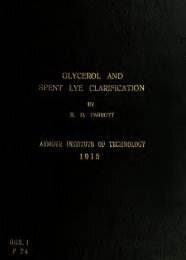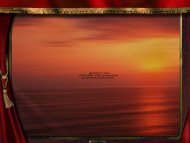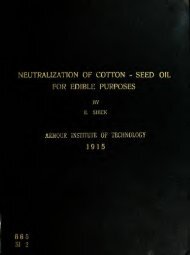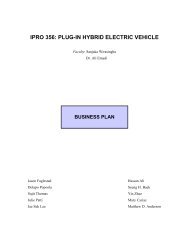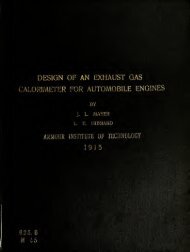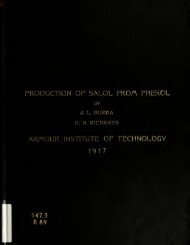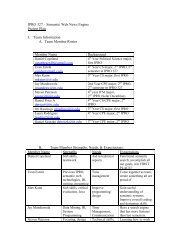Resilience tests of automobile tires under commercial conditions of ...
Resilience tests of automobile tires under commercial conditions of ...
Resilience tests of automobile tires under commercial conditions of ...
Create successful ePaper yourself
Turn your PDF publications into a flip-book with our unique Google optimized e-Paper software.
Illinois Institute<br />
<strong>of</strong>Teclinok^<br />
Libraries
'AT 318<br />
Vanderkieft, Nicholas<br />
<strong>Resilience</strong> <strong>tests</strong> <strong>of</strong><br />
<strong>automobile</strong> <strong>tires</strong> <strong>under</strong>
<strong>Resilience</strong> Tests <strong>of</strong> Automobile Tires UHder<br />
Commercial Conditions <strong>of</strong> Operation<br />
A THESIS<br />
PRESENTED BY<br />
Nicholas Vanderkieft William H. Yorke<br />
PRESIDENT AND FACULTY<br />
OF<br />
ARMOUR INSTITUTE OF TECHNOLOGY<br />
FOR THE DEGREE OF<br />
BACHELOR OF SCIENCE IN MECHANICAL ENGINEERING<br />
ILLINOIS INSTITUTE OF TECHNOLOGY<br />
PAUL v. GALVi^^i LIBRARY<br />
35 WE^'^33RD STREET<br />
CH'' L 60616<br />
HAVING COMPLETED THE PRESCRIBED COURSE OF STUDY IN<br />
MECHANICAL ENGINEERING<br />
MAY 29th 1913
Preface<br />
Table <strong>of</strong> Contents<br />
Object<br />
Table <strong>of</strong> Contents<br />
Description <strong>of</strong> Apparatus<br />
Preliminary ObserTations<br />
Method <strong>of</strong> Procedure<br />
The Running Logs<br />
The Summary Logs<br />
Calculations<br />
Plates<br />
Prints<br />
Curves<br />
Conclusion<br />
Bibliography<br />
24124
Preface<br />
Respecting the field <strong>of</strong> the theme, attention<br />
is called to the universally acknowledged fact that<br />
nearly all recent progress i the engineering art<br />
is due to experimental investigation and research.<br />
The <strong>automobile</strong> tire-testing machine was de-<br />
vised and constructed for the purpose <strong>of</strong> finding such<br />
coefficients, in advance <strong>of</strong> actual trial, as might he<br />
employed with confidence in tire construction to pro-<br />
duce definite results. Very little experimental v;ork<br />
has "been done in this field and very little data is<br />
obtainable , therefore experimental research and <strong>tests</strong><br />
are valuable in discriminating between correct and false<br />
theories in regard to <strong>automobile</strong> <strong>tires</strong>,<br />
V7e are much indebted to I.:r, Adolph Pors for<br />
the use <strong>of</strong> his tire pressure gauge and to the instruc-<br />
tions <strong>of</strong> the shops v/ho so kindly gave their assistance<br />
in the process <strong>of</strong> construction <strong>of</strong> the apparatus.
Object<br />
'She oliject v/as to conatruet tlie tire-testing<br />
apparatus v;iiicla is ovmed lay the Armour Institute <strong>of</strong><br />
Technology and to run some <strong>tests</strong> on a plain 36" x 3 1/E"<br />
Republic <strong>automobile</strong> tire.<br />
The construction <strong>of</strong> the machine, which will<br />
be described later, was accomplished, and having made<br />
the preliminary calibration observations, it was de-<br />
cided to make the runs by keeping the load on the tire<br />
constant, and vary the pressure in the tire, and the<br />
tractive effort.<br />
From these observations it is possible to<br />
calculate the slip <strong>of</strong> the tire, and the por/er loss<br />
due to the resilient action <strong>of</strong> the tire.<br />
Running the <strong>tires</strong> on a plain cast iron pul-<br />
ley will give data by tdiich a coiaparison <strong>of</strong> different<br />
msJtes <strong>of</strong> <strong>tires</strong> may be made aad it \7ill give also a means<br />
<strong>of</strong> obtaining the load, pressure and tractive effort<br />
for the point <strong>of</strong> highest efficiency <strong>of</strong> running the tire.
Description <strong>of</strong> Apparatus.<br />
The work <strong>of</strong> constructing the machine was be-<br />
gun hy outlining the work by means <strong>of</strong> drawings and a<br />
bill <strong>of</strong> material. These drawings were followed al-<br />
most exactly as they were made.<br />
The base <strong>of</strong> the machine was made <strong>of</strong> 6"3c6"<br />
wooden timbers framed together and bolted. This wood-<br />
en base was bolted to the bed plate which is located<br />
in the engine room <strong>of</strong> the main building. The ma-<br />
chine was then bolted securely to the v/ooden base, this<br />
gave a good substantial foujidation for the whole appar-<br />
atus which when running was free from vibrations.<br />
The machine proper is made <strong>of</strong> cast iron and<br />
is similar in construction to the bed <strong>of</strong> a lathe. The<br />
drive pulley, which is placed at one end, drives up<br />
to the main shaft by means <strong>of</strong> a "Maximum" silent chain<br />
and cut toothed wheels. The charcicteristics <strong>of</strong> this<br />
chain are such that it runs quietly at high speeds, and<br />
either forwai'd or baclrward. It is not affected by<br />
heat, cold, or dampness, thus rnakin
the dynamometer give the paver input to the tire.<br />
All hearings are ball hearings thus inducing the<br />
friction load to the smallest ohtainable quantity<br />
and also requiring no oil for luhrication. In the<br />
main shaft there is arranged a Imuckle Joint which<br />
permits the rise and fall <strong>of</strong> the tire when passing<br />
over humps. This may he seen hy referring to the<br />
accompaaiying photograph <strong>of</strong> the entire machine. At<br />
the tire end the main shaft is mounted in a hearing<br />
which is so constructed that it is allov;ed to moye<br />
up and dOT/n in a hall slide arrangement as the tire<br />
passes over humps.<br />
The T/heel was fitted to the drive axle and<br />
attached so that it V70uld he driven pisitively hy the<br />
main shaft. This arrangement requires a special<br />
aKile for each malce <strong>of</strong> v;heel. The v/heel axle is se-<br />
cured to the drive shaft hy means <strong>of</strong> ke^ and keyway<br />
with a set screw for further security.<br />
The tire runs on a heavy cast iron pulley<br />
v/hich is mounted to the a:cle <strong>of</strong> an ahsorption dynam-<br />
ometer, the pov;er <strong>of</strong> vAiich is calculated from its<br />
moment arm and load on the scales. The cast iron pul-<br />
ley has a dianeter <strong>of</strong> eighteen inches. The power ob-<br />
tained from the absorption dynamometer is the pov;er<br />
5
transmitted by the tire. The tractive effort is<br />
applied to the tire by varying the water pressure<br />
in the absorption dsmameter. The load on this dy-<br />
namometer is very hard to maintain constant owing<br />
to the fluctuation <strong>of</strong> pressure in the water main.<br />
It is therefore suggested that some arrangonent he<br />
made by which the pressure <strong>of</strong> the water vdll be adjust-<br />
able and thereby reraain constant. The v/hoLe test<br />
hinges on this one point <strong>of</strong> maintaining the tractive<br />
load constant.<br />
The loadings on the tire are obtained by<br />
applying weights to the I-beam which is slung <strong>under</strong><br />
the bed <strong>of</strong> the machine with a fulcrum at the drive end<br />
and fastened to the bearing at the wheel end by a<br />
steel rod having a knuckle joint inserted. This is<br />
attached to a leaf spring which is rigidly bolted to<br />
the I-beam.<br />
The revolution <strong>of</strong> the main shaft and <strong>of</strong> the<br />
absorption dsmamoraeter were recorded by two integrat-<br />
ing revolution counters which v/ere connected to the<br />
shafts by flexible spring shaftings. These are very<br />
fine instruments and were made by Mr, Falk, the school<br />
mechanician.<br />
The rebounding <strong>of</strong> the tire on the cast iron<br />
pulley was recorded by means <strong>of</strong> levers on to a re-<br />
6
YOlYing disc to vaalch a paper was attaclied. This<br />
method seeri:s to work satisfactorily so drawings<br />
are suhmitted in the accompanying thesis for a revised<br />
"braclret and perfected levers and pedestals for sane.<br />
The paper recording apparatus is to he made by the<br />
school mechanician and will he attached to the east<br />
iron bracket ?/hich v/ill be placed where, by looking<br />
at the accompanying photograph, is seen the device<br />
v/hich was used during the runs. The paper on v/hich<br />
the records are made should be arranged to travel<br />
at a kn07na speed for T;*ich E" per minute would be<br />
about right.<br />
The machine was driven by a 10 horse power<br />
variable speed motor. This allows a travel <strong>of</strong> from<br />
ten to sisty miles an hour for a thirty-six inch<br />
tire.<br />
The whole apparatus ran without any heating<br />
<strong>of</strong> the bearings which shows that as far as running it<br />
was in good condition.<br />
7
Preliminary Observations<br />
The calibration <strong>of</strong> the Eenerson ^)7namometer<br />
was made by moTinting the dynamoineter in the jaws <strong>of</strong><br />
the torsion machine by means <strong>of</strong> tv/o short pieces <strong>of</strong><br />
shafts having keys and keyways,<br />
E.P. from dynamometer equals the reading<br />
times revolutions per minute divided by 100.<br />
Thus<br />
H.P. = R 3C H i 100<br />
The H.P. from the formula is<br />
Let R equal one, then<br />
E.P. = 2 7rr<br />
33,000<br />
33,000 U = 100 z E f riP<br />
35.000 H<br />
.<br />
•"•^^ r<br />
100z2irif<br />
» r<br />
• * P = 5E,55 ft. lbs.<br />
' ' Reading 1 = 5E,55 ft. lbs.<br />
FoL107/ing are tables <strong>of</strong> figures found in the<br />
calibration <strong>of</strong> the KenersonDyaaiaometer in the torsion<br />
machine.<br />
These results have been represented in the<br />
calibration curve accompanying the thesis.<br />
8
Preliminary Observations,<br />
The preliminary observations were made<br />
to obtain the calibration curve for the Eenerson<br />
transmission dynamometer at varying loads and syeeds,<br />
v/hich incidently gave the speeds for the notches<br />
on the starting rheostat <strong>of</strong> the variable speed motor.<br />
The absorption djniamometer was blocked np<br />
with wooden blocks so as to couple it to the main<br />
drive shaft <strong>of</strong> the machine. Then it was decided<br />
to run the apparatus with varying loads and speeds.<br />
The readings <strong>of</strong> the Kenuson dynamometer v;ere talcen<br />
and also the load on the scales and the II, p.m. <strong>of</strong><br />
the main shaft.<br />
The notches on the rheostat were numbered<br />
so that #1 indicates the lowest speed and as the num-<br />
bers increase the speed increases.
10<br />
Follov/ing are tables <strong>of</strong> figures obtained<br />
in the calibration <strong>of</strong> the Kenorson Dynamometer in<br />
actual running <strong>conditions</strong>.<br />
Dead Load on Scales = 11. 9#<br />
length <strong>of</strong> moment arm = 2E 1/4"<br />
For Ho. Load<br />
Load Load Ken Br alee<br />
notch iro. R.P.H, Ken.Dyn. Scales Dyn H.P.<br />
Divs. lbs. H.P.<br />
1 167 .04 15.1 #.067 #.189<br />
167 ,04 15.1 .067 .189<br />
3 188 .05 15,1 .094 .213<br />
189 .05 15.1 .095 .213<br />
5 208 .05 15.2 .104 .243<br />
210 .05 15.2 .105 .244<br />
8 258 .07 15.5 .181 .329<br />
258 .07 15.5 .181 .329<br />
11 326 .085 15.9 .298 .462<br />
326 .085 15.9 .278 .462<br />
14 408 .100 16.5 .408 .665<br />
414 .100 16.5 .414 .675<br />
17 493 .125 17.1 .616 .910<br />
503 .130 17.3 .654 .965<br />
20 622 .190 19.1 1.180 1.590<br />
# H.P. r 167 X .04 *. 100 ^ .067<br />
-11.9 )z 167<br />
33,000 ,, '^<br />
33,000 X 12<br />
# H.P. = —2 T^riiP _ - 2¥3C 22 1/4 3C (15.<br />
" .189<br />
1
Run for 40 niles per Hour 13th ITotch.<br />
Load Load H.P. H.P.<br />
R.P.M, Ken.Djn. Scales Ken.Djm. Al)s.Dyn.<br />
378 .OE 15.3 ;.076 #.454<br />
386 .185 20 0.715 1.107<br />
376 .36 25 1.353 1.741<br />
380 .51 30 1.940 2.433<br />
370 .65 35 2.420 3.190<br />
376 .78 40 2.935 3.750<br />
375 .935 45 3.510 4.390<br />
369 1.05 50 3.878 4.980<br />
375 1.205 55 4.520 5.720<br />
371 1.43 60 5.315 6.320<br />
373 1.49 65 5.560 7.000<br />
373 1.635 70 6.100 7.650<br />
371 1.79 75 6.640 8.320<br />
370 1.94 80 7.180 8.900<br />
357 2.00 85 7.140 9.860<br />
345 2.16 90 7.449 10.180<br />
330 2.25 95 7.425 10.300<br />
322 2.40 100 7.730 10.580<br />
H.P. «s 373 X ,02
For 15 miles per hour<br />
R»P ,ii»<br />
12
for 20 Miles per hoxir. Srd Hotcli 187 R.P.M.<br />
Load Load H.P. H.P.<br />
R.P.M. E. Dyn. Scales En.Dyn. Abs.Dyn.<br />
186 .25 20 # .465 #,534<br />
186 ,'39 25 .725 .864<br />
189 .55 30 1.040 1.205<br />
186 .70 35 1.302 1.520<br />
185 .86 40 1.572 1.840<br />
182 1.00 45 1.820 2.130<br />
182 1.11 50 2.020 2.780<br />
185 1.28 55 2.370 3.150<br />
185 1.45 60 2.685 3.480<br />
184 1.63 65 3.000 3.700<br />
180 1.79 70 3.222 4.020<br />
185 1.85 75 3.365 4.060<br />
180 1.98 80 3.565 4.340<br />
174 2.09 85 3.635 4.500<br />
176 2.25 90 3.960 4.870<br />
172 2.40 95 4.135 5.060<br />
171 2.50 100 4.270 5.370<br />
E.P. = 186 z .25 4- 100 s .465<br />
^''^' "<br />
2 Wxm ^ 2 7rx 22 1/4 X (20»11.9)xl86<br />
33,000 " 33,000 x 12<br />
= .534<br />
13
Rtm for Varying R.P.M. Constant Loads<br />
R .P .M<br />
164<br />
194<br />
240<br />
300<br />
380<br />
460<br />
560<br />
168<br />
184<br />
234<br />
295<br />
380<br />
465<br />
161<br />
192<br />
235<br />
300<br />
374<br />
456<br />
16Jg<br />
192<br />
234<br />
297<br />
360<br />
420<br />
154<br />
186<br />
234<br />
290<br />
348<br />
396<br />
.<br />
Load<br />
14
nun for 30 miles per Hour. 9th lotch.<br />
15
The scales were placed <strong>under</strong> the tire and<br />
the weights niimbered and hung on the I-beam one by-<br />
one and tho following readings were taken<br />
Lead Wt. on Scales = 11 l/2#<br />
" " " " -f- Wheel and Tire = 196<br />
" " " " -^ " " +Wt. #1 = 229 .0#<br />
" #2 « 259.5<br />
" #3 = 293.5<br />
#4 = 326.5<br />
#5 = 360.0<br />
#6 a 398.0<br />
#7 = 453.5<br />
#8 = 470.0<br />
#9 ' 505.5<br />
#10 = 641.5<br />
The above figures give the actual load which<br />
i& on the tire when running. There are enough weights<br />
to apply a load <strong>of</strong> 1500 pounds to the tire.<br />
16
#<br />
Stresses and Strain in Tires.<br />
The duty that the pneumatic tire has to per-<br />
form is, very complex. So cornplex is it Ihat no one<br />
has yet been able to completely analyze it; at any<br />
rate, not sufficiently in order to be able to recon-<br />
struct en integral synthesis from the resultant analy-<br />
sis so as to evolve the elastic wheel.<br />
As soon 83 some one hi^s discovered the exact<br />
manner in which the pneumatic cushions <strong>of</strong> fn automo-<br />
bile wheel works then the problem <strong>of</strong> the elastic or<br />
resilient wheel will be mostly solved.<br />
It is proposed to show the nature <strong>of</strong> the ef-<br />
forts supported by the <strong>tires</strong>, their approximate direc-<br />
tion in the order <strong>of</strong> sizes.<br />
17<br />
It ip proposed to classi:^ the efforts to which<br />
the tire is submitted in strtic efforts (these are the<br />
efforts that act upon the tire when the car is standing<br />
still), and dynamic efforts, thft is to say, efforts<br />
thft are crused by the diverse movements <strong>of</strong> the car.<br />
Static Efforts.<br />
It is assumed that a tire presents geometrical-<br />
ly the exact form <strong>of</strong> a tore. This hypothesis is as<br />
# The dimensions <strong>of</strong> <strong>tires</strong> are given in metric numbers<br />
because these fi^<strong>tires</strong> were obtainable from the Auto,<br />
Sept. 14, 1911.
near the truth as it is possible to g^o ani in every<br />
cpse the eri'ors thf t mej be made in aiopting; it are<br />
much less than approximation that we hope to attain.<br />
It will be remembered that R is the mean ra-<br />
dius <strong>of</strong> the tore, r the radius <strong>of</strong> the meridian circle.<br />
The dimensions by which <strong>tires</strong> are usiially denoted rre<br />
expressed by<br />
and<br />
2(R -^r) (diameter <strong>of</strong> the parallel equator)<br />
2r (diameter <strong>of</strong> the meridian)<br />
supposing p to represent the difference in pressures<br />
(expressed in lbs. per square inch) between the air<br />
enclosed in the inner tube Pnd the atmospheric air.<br />
18<br />
The figure p will be the reading on a pressure<br />
gauge applied to the valve.<br />
po will denote the initial pressure to which<br />
the tire was inflated, or to be more exact we will<br />
call po the value that p will take when the tire is<br />
not opposed to any exterior effort, the temperature<br />
<strong>of</strong> the air inside being the same as the exterior air<br />
at the moment <strong>of</strong> inflation.<br />
po will therefore be the theoretical pressure<br />
indicated by the makers, which are given in table I<br />
as a guide for inflating <strong>tires</strong>.
finally we will alrait for the calculations<br />
<strong>of</strong> tensions supported by the canvas, that<br />
1. That the tire is perfectly souple<br />
.<br />
19<br />
2. Thpt the canvas does the work, the rubber <strong>of</strong><br />
the inner tube and outer cover not supporting any effort<br />
3. That the canves known as straight grain in-<br />
cluded in the arc rre not affected by the effort due<br />
to the internal pressure.<br />
Superficial Tension.<br />
One knows that an elastic membrpne separating<br />
two gaseous masses, the pressures <strong>of</strong> vrhich are differ-<br />
ent, supports en effort <strong>of</strong> traction \''hich is a com-<br />
ponent <strong>of</strong> the differences in pressures and <strong>of</strong> the curv-<br />
ature <strong>of</strong> the membrane<br />
.<br />
If the radii <strong>of</strong> the principal curvatures are<br />
designated by r and R rt e r^y point <strong>of</strong> the inflated<br />
tire, the surface tension will have a value at this<br />
point<br />
—<br />
P .<br />
A = 1 ^ r-<br />
It is interesting to note the VEri&tions <strong>of</strong> the<br />
principal curvature <strong>of</strong> the tore at the different points<br />
f t he surfe' ce .<br />
The minimum radius R is evidently equal to the<br />
constant value <strong>of</strong> the meridian circle.<br />
R' = r<br />
Thn radius R maaimum will vnry according to
the different points <strong>of</strong> a £:iven msriiian.<br />
20<br />
It will be es well to give it a positive (in<br />
the same manner as r') when the curvfture will have<br />
its concavity turned toward the interior. Taking<br />
Fig. 1 as an example denoting- a msridien section<br />
<strong>of</strong> the tore.<br />
At the point A we have<br />
R* - R -r r<br />
Considering the displacement from A to B the<br />
curvature diminishes until it becomes nil at B. R' will<br />
grow'^Se finitely from A to B while rf^-maining positive.<br />
In displacing from B to C the curvature be-<br />
comes negative find augments the pbsolute value. The<br />
ri dius <strong>of</strong> the curvature vp.ries from to -(R~r).<br />
the two values.<br />
and.<br />
The suifece tension A varies therefore between<br />
1-1<br />
r R-r<br />
1 1<br />
r ' H<br />
-f- r<br />
It is easy to see that the maximum will be at<br />
the point C. In feet the denominator is maximum when<br />
R» is negative and equal to R-H.<br />
The meximum surface tension is therefore
Am =<br />
- p<br />
r(R-II)<br />
R-2II<br />
1<br />
SI<br />
It will be interesting to see how this compares<br />
with different sizes <strong>of</strong> <strong>tires</strong>. First <strong>of</strong> all it should<br />
be noted that R is always much gmater than r. We have<br />
therefore for the current dimensions <strong>of</strong> <strong>tires</strong> <strong>of</strong> cars<br />
the following:<br />
(700x90<br />
(<br />
(790x90<br />
(<br />
(790x90<br />
R = 30.5 cm.<br />
R = 38.5 cm.<br />
R = 41 cm.<br />
if 020x120 R - 35 "<br />
(<br />
(920x120 R = 40 "<br />
(895x135 R = 38 "<br />
(<br />
(935x135 R - 40 "<br />
r = 4.5 - = about 7<br />
r = 4.5 S a<br />
r = 4.5<br />
r « 6<br />
r * 6<br />
r = 6.8<br />
r - 6.8<br />
R<br />
f<br />
R<br />
II<br />
'7.5<br />
'9<br />
6<br />
6.8<br />
5.5<br />
The pressure p to which <strong>tires</strong> should be inflated varies,<br />
PS everyone knows, with the diameter <strong>of</strong> the tire. That<br />
is why <strong>tires</strong> <strong>of</strong> 90 millimeters section should be inflated<br />
to 5 kilograms, 120 m.m. section to 6 kilograms, and 135<br />
±m. sections to 7 kilograms.<br />
It is easy to see how for the same section and<br />
also for the same pressure the maximum surface tension<br />
will vary.
The fraction<br />
It is expressed by<br />
Am = pr<br />
R - r<br />
R - 2U<br />
22<br />
Poi* the saiOB section the product pr is coristant.<br />
S- 1<br />
r<br />
R - 2<br />
r<br />
is greater than unity, and will decrease when ^<br />
increases. Prom which it is possible to draw the<br />
following conclusions:<br />
The surface tension is proportionately smaller<br />
for a given section <strong>of</strong> the tire as the diameter <strong>of</strong> the<br />
wheel increases.<br />
If we consider the v:rious sections <strong>of</strong> casings<br />
we can find out that the suifece tension is proportion-<br />
ately greater as the tire increases in sii:e.<br />
In fact, in the product<br />
H - 1<br />
A = pr n<br />
K „ 2<br />
the title p will increase when r increases.<br />
This tsble will show that — diminishes when H
inoreases.<br />
vrith r.<br />
23<br />
The three factors p, r, £ will increase<br />
K - 2<br />
N<br />
That is vftiy a 700 x 90 tiro will have a su-<br />
perficial maximurn tension:<br />
7-1<br />
Am = 5 X 4,5 7 - 2 - 27 kilograms.<br />
Ajj 875 X 135<br />
Ad « 7 X 6.9 ^*^ " ^ r kilograms.<br />
5.5-2<br />
It is for this reason th^t tire makers manu-<br />
facture the tiros with a proportionately greater num-<br />
ber <strong>of</strong> layers <strong>of</strong> canvas as the diameter inoreases.<br />
90 m.m. section <strong>tires</strong> usuelly hevo 4 layers<br />
<strong>of</strong> canvas, while 135 m.m, sections heve 7 layers <strong>of</strong><br />
canvas.<br />
The proportion iniicritei hy the calculation<br />
does not seem to have been followed. This is ac-<br />
counted for by the fpct thft in all times efforts<br />
independent <strong>of</strong> the diameters must be t&ken into con-<br />
sideration, which Till be explained later. So that<br />
if the number <strong>of</strong> layers <strong>of</strong> canvas to be used is de-<br />
noted by n and a the tension to support each one<br />
<strong>of</strong> them, n must be calculated from the formula
A<br />
n » a'<br />
which is rational if the siirface tension were not taken<br />
into consideration, but it must he calculated from<br />
the following:<br />
n = no -^ — .<br />
a<br />
The warp end the wo<strong>of</strong> threads in pneumatic<br />
<strong>tires</strong> are placed at an angle <strong>of</strong> approximately 45 de-<br />
grees in the principal plsne <strong>of</strong> the sxacfaee. As<br />
the resistance <strong>of</strong> the ctmves is none other than that<br />
<strong>of</strong> the warp and the wo<strong>of</strong> it is interesting to look<br />
for the resistances imposed on the threads.<br />
In articles thr t have appeared on the manu-<br />
facture <strong>of</strong> <strong>tires</strong>, we find that the angle <strong>of</strong> the<br />
threads, vihich is about 90 degrees pt the brad, corr.es<br />
down to 70 degrees at the center portion <strong>of</strong> the tire.<br />
It is proposed to first <strong>of</strong> rl 1 calculate the<br />
tensions followinf- the principal plsnes at the points<br />
A and c in E'ig. 1.<br />
Supposing the tire cut in a meridian plane.<br />
The layers will hfve to withstand r resistance as<br />
fellows in order to remain stuck together:<br />
^-^^<br />
V II T<br />
ilr<br />
which equals 2£<br />
2<br />
24
25<br />
This is the tension in the equatorial plane<br />
which cfn be designated by T .<br />
E<br />
If v;e now cut the tire in the equatorial<br />
plane the force which will tend to s the two<br />
halves v.lll be eqiial to<br />
thi^.t is to say<br />
and Tm. Max.<br />
p(Tl (R + r)^ - 7l(R-r)^)<br />
4 TTRrp<br />
.<br />
Let these meridian tensions be Cflled Tm.Min.,<br />
Hear the beads the threads <strong>of</strong> the canvas are<br />
ft an angle <strong>of</strong> 45 degrees to the direction <strong>of</strong> merid-<br />
ian and equatorial tensions.<br />
be (see Pig, 4)<br />
that is<br />
,<br />
:<br />
The tension t following these threads will<br />
t = - (Tg -f-Tm.Max.)<br />
s gr gR > r .<br />
2^f2 Rr<br />
At a point <strong>of</strong> the great equatorial circle vhere<br />
the threr.ls form between them vn angle 0( (\y(90 ) the<br />
tension <strong>of</strong> these threads will be according to Pig. 5.<br />
( Tm Tr. )<br />
„ 1 (ooBi!^ sin '-; \
that is<br />
sizes <strong>of</strong> covers.<br />
T " 2 Pr ^R^U cos (^ 2 sin X ^<br />
2 £<br />
26<br />
Let us fpply "ttiese formulas to some standard<br />
1** 760 X 90 R = 33.5 11= 4.5<br />
Tension at the Bead <strong>of</strong> the cover<br />
t = 5 X 4.5 . 55.5 X S - 4.5<br />
2YT 29<br />
= 26.5 kilograms<br />
The tension et the running tread (angle <strong>of</strong><br />
the threads 0< - about 80°)<br />
* "<br />
as oan be seen.<br />
5 s 4.5 ( 32.5 , 1 )<br />
2 (38 cos. 40° 2 sin 40° ^<br />
- about 21 kilograms<br />
The tension is apprecif^bly less at the thread,<br />
This explains why when a tire bursts (un-<br />
less the burst is due to a cut) the tear generally<br />
takes place at the sile wall. Near the point <strong>of</strong><br />
attachment where the tension is greatest, the tire<br />
is reinforced by the two small layers. ually<br />
the tire bursts Just below these layers.<br />
The tensions thft have been calculated shows<br />
what is supported by the general bo3y <strong>of</strong> cpnvas<br />
.
Uerr the rim the two layers must be taken<br />
into consideration as well and the totf-l tension<br />
divided by six<br />
£§i^ = 4.5 kilograms<br />
27<br />
Canvas <strong>of</strong> good quality should not break un-<br />
less submitted to tn effort <strong>of</strong> 56 kilos, per square,<br />
centimeter. The ooefficient <strong>of</strong> secutiry is there-<br />
fore 1'^.<br />
Another interesting point is pt what part<br />
<strong>of</strong> a tire the work <strong>of</strong> each layer <strong>of</strong> canvas is great-<br />
eat, granted that their number is variable.<br />
Hear the point B in Fig. 1, it can be seen<br />
that the tensions in the main planes pre respectively<br />
meridian:<br />
T'^nBion in the perpendicular plane at the<br />
t = Te<br />
- pl 2<br />
Tension in the meridian plane:<br />
r<br />
2 X 27rR<br />
pr.<br />
The angle thrt the threads make beingO< at this<br />
point, the forces that will act upon them cen be ex-<br />
pressed by (Pig. 5)
„ . 1 ( IS+ ^1 3 28<br />
2<br />
E ^<br />
continuing to osll Tj, the tension in the main<br />
plane perpenlicular to the meridian plane.<br />
But in replacing Tm and T^ by their values<br />
, (_i i— )<br />
T = r P^^cos -^ 2 sin o<<br />
'<br />
The angle <strong>of</strong> the threads for the 760 x 90<br />
tire that we hi^ ve chosen is, for example, about 85<br />
degrees.<br />
From which the value <strong>of</strong> T:<br />
J,<br />
- J X S X 4.5J<br />
( 0.757 1 )<br />
r about E2.5 kilograms.<br />
1 2x0.676 j<br />
This tension is much greater thsn that which<br />
exists at the rolling tread.<br />
At the point B (in Fig.l) the number <strong>of</strong> layers<br />
<strong>of</strong> canvas is only 4. The tension <strong>of</strong> each thread <strong>of</strong><br />
the oanvps has a value<br />
£il^ - 5.5 kilograms.<br />
4<br />
More, therefore than the tension <strong>of</strong> the bead.<br />
The tension increasing when a displnceraent is<br />
mrde firom B to C, it opn easily be seen that the ten-<br />
sion <strong>of</strong> oach strand or thread will be a maximTim fol-
lowing rlong the border <strong>of</strong> the bead strip.<br />
29<br />
This is borne out by practice. When a tire<br />
biirsts prematiirely it generally takes piece at this<br />
point.<br />
11^ 820 X 120 tire R = 35 K = 6<br />
^ = about 6<br />
IT<br />
In applying the forinula we have:<br />
1. Tension at the bead for the entire canvfis structure<br />
( p = kilogs.)<br />
2"V2' R - K<br />
s 44 kilogs<br />
which for each layer equals:<br />
i^ r<br />
8<br />
.<br />
kilogs.<br />
taking the side strip into consideration.<br />
2. Tension at the running tread (
with<br />
so
which for each thread equals<br />
^Q*^^ s 7.2 kilogs.<br />
7<br />
31<br />
It will be seen from the foregoing that the tension<br />
for each thread proportionately increases with<br />
the increase in diameter <strong>of</strong> ttie tire. But in all<br />
oases the coefficient <strong>of</strong> security remains superior to 8.<br />
Thif! high coefficient <strong>of</strong> secririty shows that<br />
a tire cannot burst <strong>under</strong> normal <strong>conditions</strong> through<br />
sji additional excess <strong>of</strong> pressure.<br />
The tensions <strong>of</strong> the canvas being always pro-<br />
portional to the internal pressure, it can be seen<br />
oven in t?ie most unfavorable case, viz.; that a 135<br />
m.ra. tire, that it would be necessary to raise the<br />
internal pressure to 56 kilos, to arrive at a tear-<br />
ing point <strong>of</strong> the canvas. In practice the tire will<br />
probrbly biirst before this limit is reached, owing<br />
largely to the inevitable imperfections <strong>of</strong> menufact-<br />
ure due to th:- unequal tension <strong>of</strong> the canvas.<br />
But the fact remains, ho^vev-^r, that practical<br />
<strong>tests</strong> that have bf?en carried out by the simple means<br />
<strong>of</strong> increasing the internal pressure in order to burst<br />
a tire heve been without result; in nearly all cases<br />
the rims become deformed, £^llowing the beads <strong>of</strong> the tire
to fly out before the tire shows signs <strong>of</strong> weakness.<br />
32<br />
If a tir? is ol^ end the canvas hf s been sub-<br />
jected to the action <strong>of</strong> the huini3.ity to a point <strong>of</strong><br />
becoming rotten (which is a state thrt exists more<br />
<strong>of</strong>ten thfr one would think, for although the tire<br />
looks to be in good condition) b burst csn very easily<br />
take plica.<br />
Action <strong>of</strong> 'he Temperature.<br />
It is interesting to note the influence <strong>of</strong><br />
the temperature on the interne 1 pressxires in <strong>tires</strong>.<br />
Suppose a tire to be inflated at to e regular<br />
pressTU-e <strong>of</strong> 10 kilogs. Diiring the course <strong>of</strong> the day,<br />
<strong>under</strong> the simultf neons action <strong>of</strong> the sun end especial-<br />
ly the speed an! weight <strong>of</strong> the car, the imprisoned<br />
air cr.n attf in a temperature <strong>of</strong> 80 Centigrade, con-<br />
sooxiently producing rn increase <strong>of</strong> pressure.<br />
equal<br />
The pressure p attained at this moment will<br />
p = pO ( 1+^t)<br />
that i3 to say p = p° ( 1+ ^j<br />
~ p° X 1.3 about<br />
The pressure will only rise in the third <strong>of</strong> the<br />
primary value. The proportional increase <strong>of</strong> the ten-<br />
sion and the canvas for a tire in good condition is
more or less a negll£:il3le quantity.<br />
35<br />
Further, when one talks <strong>of</strong> the causes <strong>of</strong> the de-<br />
torioration <strong>of</strong> <strong>tires</strong> it vd 11 bo seen tht t the action<br />
<strong>of</strong> the heat on the rubber is more important th^n on<br />
the internal pressure.<br />
Action <strong>of</strong> Weight on Tension <strong>of</strong> Canvas.<br />
All that hp s previously been stated refers<br />
to <strong>tires</strong> sinply infleted and not carrying any weight.<br />
There is nothing to be modified in the conclu-<br />
sions drawn is one only passes to a precticFl case<br />
"here the tire rests upon the groiind &nd carries a<br />
weight P (It will be remembered that we are only inter-<br />
ested at the moment in static efforts - that is to say,<br />
the case where the tire is stationary.<br />
Under influence <strong>of</strong> the charge the tire will<br />
flatten out until the force exerted by the internal<br />
pressure on the surface <strong>of</strong> contact equilibrates the<br />
weight supported.<br />
Allowing for the stiffness <strong>of</strong> the cmvass it<br />
can be seen that we will have the equation<br />
ps = P<br />
calling s the suifeoe <strong>of</strong> contact <strong>of</strong> the tread with<br />
the ground and measured in square centimeters.<br />
This contact ?rea is not in the foim <strong>of</strong> a
34<br />
well-asfined geometrical form. It can be likened<br />
to fn ellipse, tiie greater axis <strong>of</strong> vdiich lies in<br />
the lateral plane <strong>of</strong> the wheel. This ellipse will<br />
be pr oportions tely lengthened accoriing to the npr-<br />
rovmess <strong>of</strong> the tire and the increase in diameter <strong>of</strong> the<br />
wheel.<br />
It can be seen that the work necessary for the<br />
propulsion <strong>of</strong> the car is dependent on the form <strong>of</strong> this<br />
surface, and is greater according to the relation <strong>of</strong><br />
the large and smaller axis being smaller.<br />
The flattening <strong>of</strong> the tire produces a depression<br />
on the interior <strong>of</strong> the crsing anl the volume there-<br />
<strong>of</strong> diminishes slightly, due to this fLrttening. The<br />
increase in pressure is quite insignificant end need<br />
not be considered. The point i^^ioh must be borne in<br />
mind, however, is the change in the form <strong>of</strong> the mer-<br />
idian section <strong>of</strong> the tire at the point <strong>of</strong> contact with<br />
the ground. ?ig. 7 shows in an exaggerated form what<br />
tfkes plpoe.<br />
If the tire were very narrow or, on the other<br />
hand, formed <strong>of</strong> a single layer <strong>of</strong> canvass this defor-<br />
mation would not be <strong>of</strong> great importance. But ss the<br />
various Ipyers <strong>of</strong> crnvrss present ^ considerable thick-<br />
ness, it follows that to pass from the normal form<br />
to the farm represented in ?ig. 7, the layers <strong>of</strong> can-
35<br />
vasxLll slide on one another. This displecement is<br />
possible owing to the layer <strong>of</strong> rubber compound inter-<br />
posed between each layer; the rubber stretches at the<br />
points extended and contracts pt the others, permit-<br />
ting a small relative displacement.<br />
It is clear that this sliding should be as<br />
small as possible; the tensions that are developed<br />
between the layers <strong>of</strong> canvas f^nd their coating: <strong>of</strong> rub-<br />
ber develop values proportionately greater as the dis-<br />
placement increases, tensions which oould in time<br />
cause the rubber to become detached from the canvas.<br />
On the other hsnd, on account <strong>of</strong> the hystersis<br />
that accompanies all phy-ical phenomena, in the present<br />
Ofise the deformations <strong>of</strong> the rubber, during the move-<br />
ments <strong>of</strong> the revolutions <strong>of</strong> wheel successive deforma-<br />
tions <strong>of</strong> the diverse sections ere accompanied with a<br />
con si ier able production <strong>of</strong> heat.<br />
In a Ir-rg-e measure it is due to this that a<br />
tire that is insufficiently inflated bursts more than<br />
the same tire submitted to the same change, but in-<br />
flated to a greater degree. Anot er cause <strong>of</strong> heating<br />
lies in the friction <strong>of</strong> the tire with the groxind.<br />
Method <strong>of</strong> Attachment.<br />
The tire is held in position in the rim by the<br />
pressure <strong>of</strong> the air on the beads.
It is inter-^sting- to farm an idea <strong>of</strong> the<br />
greatness <strong>of</strong> the force that holis the tire in position.<br />
The tire in the vicinity <strong>of</strong> the siies <strong>of</strong> the bead is<br />
subraittel to the action <strong>of</strong> two forces: the oned^fsuper-<br />
fi;3ial tension) tends to drav: the bead outward, the<br />
other P (arising from the internal pressure) has<br />
on the contrary action <strong>of</strong> forcing the bead into the<br />
base <strong>of</strong> the rim (Pig. 6).<br />
On account <strong>of</strong> the form <strong>of</strong> this latter, it is<br />
possible for the bead to turn towf rd the point A fal-<br />
lowing for the resistance <strong>of</strong> the canvas). Then "the<br />
force e<br />
?or the unity <strong>of</strong> the length <strong>of</strong> the tire the<br />
force p ia equal to: pxl.
The force 6 is the iUBximum merilian section<br />
tension <strong>of</strong> the tire. It is expressed by<br />
Rr<br />
Tm = „ R - r<br />
Prom whidh<br />
The resiiltant couple, which re will call the<br />
couple <strong>of</strong> security, villi he equal to the difference <strong>of</strong><br />
the coniponents<br />
as possible.<br />
.<br />
0=21<br />
= 2( R - rj<br />
It should be positive and have ^ a lerge a value<br />
Let us calculate this value for current dimen-<br />
sions <strong>of</strong> <strong>tires</strong> (90,120,135)<br />
The VTilue <strong>of</strong> G can be written<br />
2 R )<br />
C = I ^ 1 - • YTi ^<br />
r<br />
?rom the foregoing it becomes at once appar-<br />
ent thet G will be proportionally smaller as R der<br />
creases in size.<br />
The vplues <strong>of</strong> — are rf.ven in the table earr<br />
lier in the writing.<br />
The minimum values are:<br />
f for <strong>tires</strong> 700 x 90<br />
6 " " 820 X 120<br />
5.5 " " 895 X 135<br />
It 7: ill be remorabered that for each section<br />
37
38<br />
R is proportionately smaller as the size <strong>of</strong> the<br />
r<br />
v;heel is smaller.<br />
R<br />
The corresponding vrlue <strong>of</strong> R_]^<br />
r<br />
are respootively 3.5 6.3 8.5.<br />
The thickness e is approximately ecjual to<br />
1 m.ra. per layer <strong>of</strong> canvas as<br />
6 m.m. for a tire <strong>of</strong> 90 m.m. section.<br />
3 " n TT If rt ]^2Q »f tf<br />
g n »f IT If Tf ]_35 " '<br />
But for a 9o m.m, section tire the wiith<br />
<strong>of</strong> the beai is about 23 m.m.<br />
prom vfcich for C<br />
C ^<br />
= 1}<br />
z -I 2.3" - 0.6 X<br />
3.5J<br />
:: p X 1.6<br />
8 kilo-centimeter per c^-^ntimeter.<br />
It is necessary, therefore, that the wiith<br />
<strong>of</strong> the heals increase with the tire wiith.<br />
To obtpin a like value for C with the tire<br />
895 X 135 (taking into consl deration the internal<br />
pressure) it is necessary to make the beads 33 m.m.<br />
wide.<br />
:
Effect <strong>of</strong> Speed on Tire Wear,<br />
The 3estriictive effect on <strong>tires</strong> increases<br />
rr>pia ly with the speed, because or the increased<br />
shock, slipping and braking streeses at high speed.<br />
39
The Power Consumption <strong>of</strong> Tires.<br />
In Gonsiiering the power consumption <strong>of</strong> au-<br />
tomobile <strong>tires</strong>, the electric <strong>automobile</strong> has<br />
entered so largely into the <strong>tests</strong> and. researches on<br />
the subject.<br />
The weather coniitiona have a considerable<br />
effect on power consumption <strong>of</strong> <strong>tires</strong>. On a warm<br />
day when the asphalt is hot ani dry, pneumstic <strong>tires</strong>,<br />
especially if they ere not inflated very herd, seem<br />
to cling to the road's surface, and certcrinlj' cause<br />
more power to be consumed. If the surface is wet<br />
the power consiunption immediately becomes less. If<br />
the sxufece is not only wet but oily or greasy, it is<br />
smaller yet. The reason for this is that there is<br />
considerable motion between the tire and the road<br />
suifeoe, not so much a direct rotary motion, which is<br />
<strong>of</strong> course, slippage, but a crosswise motion, ?ue to<br />
the flattening <strong>of</strong> the tire as the wheel rotates and<br />
the load comes upon it. when the road surface is wet<br />
or greasy the frietional surfaces are lubricated, raid,<br />
<strong>of</strong> ooixrse, the motion takes place with less friction<br />
and power loss. The surface which a tire presents to<br />
the ground when it is not loaded is shown in Fig.l.<br />
Pig. 2 shows the surface the tire presents when it is<br />
sustaining the weight <strong>of</strong> the vehicle and load, and is<br />
40
properly inflated. These contours can be obtainei<br />
by painting e portion <strong>of</strong> the tread <strong>of</strong> the tire and<br />
while the paint is still fresh turning the wheel van.-<br />
til its ftill weight rests on a sheet <strong>of</strong> paper suit-<br />
able for recording the impression.<br />
41<br />
Rubber <strong>tires</strong> rre popularly supposed to be used<br />
on <strong>automobile</strong>s for three purposes;<br />
First, for providing a resilient cushion<br />
supplementary to the springs between the ground and<br />
the car to relieve the passengers and the raechsnism<br />
<strong>of</strong> jar and vibration, and to reduce noise.<br />
Second, to prevent the wheels from skidding<br />
end slipping on the road surface.<br />
car run easier.<br />
Third, to reduce road friction and make the
Method Procedxire<br />
The following; dpta is the result <strong>of</strong> four<br />
tv;o hour runs which were m'^le on a ?6" x 3 1/2" Hepuh-<br />
.<br />
42<br />
lic Plain Automobile Tire. At the end <strong>of</strong> the first<br />
reading <strong>of</strong> the fifth run the tire burst and as no<br />
other <strong>tires</strong> werg available, it was decided to stop<br />
with the small amount <strong>of</strong> data which had been obtained.<br />
It is therefore impossible to draw any conclusion<br />
from the results obtained.<br />
A few bumps were allowed to pass between the<br />
pulley and the tire. This, however, was not done<br />
for any experimental pxirpose as this was beyond the<br />
scope <strong>of</strong> our thesis. As a matter <strong>of</strong> interest, how-<br />
ever, we include two diagrams which were recorded as<br />
an inch block <strong>of</strong> pine was r llowei to pass through.
Conclusion.<br />
Prom the sumnary log it cr-n be seen that<br />
the horse power loss through resilience is very<br />
great comppred with the horse power input. These<br />
losses are respectively: 63%, 39.5%, 39%, 62.5%,<br />
showing that for heavy loads the percent age loss<br />
is smaller than for lighter loads. These losses<br />
are probably somewhat high, in our case, as it was<br />
very difficult to maintain constant <strong>conditions</strong> at<br />
the absorption brtke due to water-haraner in the<br />
line.<br />
43<br />
The slippage, fs might be expected, increases<br />
with the load, although the result <strong>of</strong> the second run<br />
looks very doubtful.<br />
The tire which was a Republican 36" x 3 l/2"<br />
did not stand up well. This is probably due to the<br />
fret that it has been allowed to stand in the engine<br />
room, for a year, or more, where s temperature <strong>of</strong> from<br />
loo to 120° is mnintsined almost all the time. The<br />
tire gave way without any warning and although it<br />
heated up somewhat :^urinr the run it did not reach a<br />
danger axis t e rap era tu re .
RUNNlNGi<br />
GFiUBRFiT)ON<br />
KENER50N TRANSMISSION<br />
Load on Scales I --<br />
L/ lO I Dovsin Up Down<br />
a°\z.a
RVNNlNGc<br />
CRDBRRTION<br />
KENERS^N TRflNSMISSION PYNQMO.<br />
Load on Scales Load on Oaocie.<br />
Up Down il^ ' r^ "
Rl^NNINGr L(?
SUMMARY LOCx<br />
C/=lLlBR^TlON<br />
KENER50N TRANSMISSION DYNQmo.<br />
Load on Dyn.<br />
Divi'si ons.<br />
Load on Scale<br />
Corr&cTed.
UJ fe<br />
) o ^ "o (D<br />
s; ^ o o vo<br />
^--v. Q w<br />
J<br />
0- 0* *- Cq CD "^<br />
6 6 00 o c;<br />
_ . 04 M
I<br />
i
I- Is<br />
J^ VS vv<br />
t^ ^N nS 00 t^ f^<br />
- 1 m<br />
CD CO «) ^<br />
Q r^. IT- ^
?L/TOMOBILE TIRE<br />
TESTING M/qCHINE.<br />
Sl/MMRHYLoa SIZEOFTIRE..
Ficj.4- Plaqram Shovs/ i nl^ a 46° finqle.<br />
ii c^-5~/^/digram Shovvina rne Tension <strong>of</strong><br />
/Ae -fhreads ai a 45°fin
Fic^./-5how/'/7a Chon^fc in Form o-fJ^eridian<br />
SecT'on o-f/nsu///cier;T/yIn{Jarec/ Tire.
c/Lc/?(yM
I'l
jft'^
j ,^<br />
,<br />
,<br />
^



